|

71ème régiment
d'infanterie américaine - 1944

71st
Infantry Regiment
Ed. Baton Rouge, 1946
The first companies
of the Regiment entered combat on the twenty-third of
October, 1944. They relieved elements of the 315th
Infantry Regiment of the 79th Division east of Luneville,
France, in the vicinity of Embermenil. The Regiment
occupied dug-in positions in Le Remabois and in the
eastern part of the Foret de Parroy. In the last week of
October and the first weeks of November, with a series
of night attacks, the First Battalion drove the Germans
from their remaining strongholds in the forest. By
continued and active patrolling, the Germans were kept
from any effective offensive action in this part of the
line.
One of the more daring patrols of this time was made on
31 October by four men from Company E: S/Sgt. R. B.
Lawrence and Harold L. Hunt and Pfc. Collie R. Martin
and John F. Larkin. These men volunteered to investigate
a patch of woods that was suspected of concealing a
mortar position. The patrol moved into the woods and,
upon discovering more of the enemy than had been
anticipated, withdrew and directed an artillery
concentration on the area. They then moved into the
woods a second time, discovering a machine gun
emplacement and mopping it up. Proceeding farther they
found a mortar position which they destroyed completely.
Next they discovered an active observation dug-out and
by moving within point-blank range opened fire and wiped
out the position.
The patrol accomplished its mission so effectively that
no further enemy activity originated from the wooded
area. Pfc. Collie R. Martin was killed in the course of
this patrolling action. All four of the men were awarded
the Bronze Star Medal for their achievements.
Typical of the bravery of the Regimental Medical
Detachment in this period was the action of Pfc. Daniel
W. McCarty. On the 26 October, he left his sheltered
position during an intense mortar and artillery barrage
to go to the rescue of five wounded men. Administering
medical aid to them while still under heavy fire, he
prepared all the men for speedy evacuation. McCarty's
action undoubtedly contributed to the saving of their
lives. For his gallantry, McCarty was awarded the Silver
Star and the Croix de Guerre.
These last weeks of October and first weeks of November
are remembered as a long ordeal of foggy rain and soggy
mud. As the days went on, the rain became more
insistent, driving its wetness to the very skin of the
soldier. The men wore wet clothing for days at a time.
Fox-holes and gun positions were flooded and caved in
again and again. The men found themselves living and
fighting in a brown sea of oozing, sticky mud. Trench
foot became a greater danger to the individual than
enemy shrapnel. A hot meal served while in reserve was a
greater treat for the front-line soldier than a dinner
with music at the Waldorf would have been to the average
citizen.
Neither the K-ration caramels nor a German broadcast
could cheer the weary infantry. Company B reported that
at 2215 on 1 November 1944, an enemy loudspeaker
broadcast the following message: "Welcome, men of the
Forty-fourth. War is Hell. Come over to our lines and
get a hot meal." The Regiment made the war a little more
hellish by replying with its mortars and calling down
artillery fire.
On the 13 November 1944, the Regiment first took the
offensive, launching an early morning attack in the Les
Remabois Woods between Embermenil and Leintrey. It was a
cold morning and the combination of the first snowfall
of the season and the deep mud made battle conditions
extremely difficult. The 71st Infantry, with the 114th
Regiment on its right flank and the 324th Regiment on
its left, began the first of a series of thrusts that
resulted in the liberation of Sarrebourg, one of the
major cities of Alsace.
The initial attack began at 0710, meeting stiff
resistance almost immediately, with two battalions being
stopped by constant artillery, mortar, and small arms
fire. Company I pushed through, capturing Leintrey by
0930, the first of many villages and towns liberated by
the Regiment, and went on to take Hill 310, its initial
objective. In this engagement the company suffered 90
casualties in three hours. The rest of the day was spent
by all battalions in consolidating the new positions,
preparing for the expected counter-attack, and readying
themselves for a new attack the next morning. The bitter
cold continued, and cases of exposure and trench foot
were numerous among all units. In many cases it was
impossible to get adequate supplies through to all the
men because of the constant shelling of positions by
massed enemy artillery.
At 0700 the next day the attack was resumed, resulting
in limited gains for all units, but on the fifteenth of
November the enemy lines were broken and the first
German defensive positions overrun. The Second Battalion
took up positions on the right flank of the Regiment
with a view to establish contact with the 79th Division
which had been recommitted to the line. In a short
period of time enemy resistance ceased to be the bitter,
effective machine it had been up to this point, and the
towns of Amenoncourt, Autrepierre, Gondrexon, Repaix,
and Igney fell to our troops in the following two days.
On the eighteenth, Company K was engaged in attacking,
when the leading elements came under the heavy fire of
German machine guns, which completely dominated the draw
through which the company must move. The constant
gunfire, by halting the advance of one company, had
slowed the entire Third Battalion. Upon learning of the
machine gun locations, Capt. Walter J. Reilly, commander
of Company K, went forward to direct the attacks against
them. He rallied his men and led them forward, firing
his carbine from the hip as the group advanced. This
action brought him under fire from one of the guns and
he was seriously wounded. Despite this fact, Captain
Reilly kept advancing, firing constantly until he was
again hit, this time fatally. His action resulted in the
destruction of the gun crews and enabled the Third
Battalion to continue to advance to its objective with a
minimum number of casualties. Captain Reilly's courage
and complete disregard for his personal safety were
inspirations to his men, and for this heroic action he
was awarded posthumously the Distinguished Service
Cross.

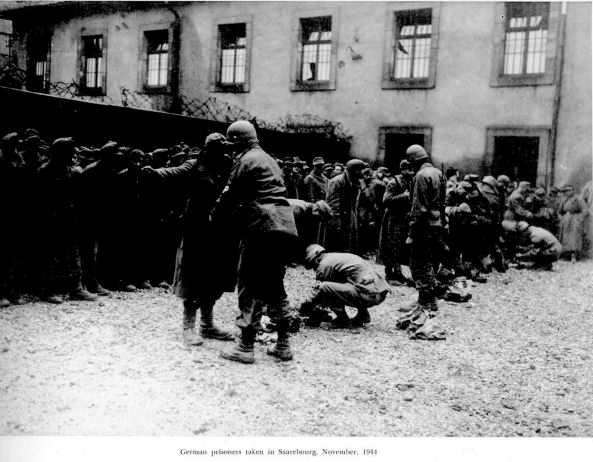
Pushing on under close support from both our tanks and
air corps, the village of Foulcrey was entered by troops
of the First Battalion while it was still afire from
effects of our dive-bombing during the day. The next day
Ibigny fell-one more step on the road to the objective,
Sarrebourg. From Ibigny the Third Battalion riding atop
tanks, and the First Battalion mounted on trucks were
set out immediately, while the Second Battalion remained
in town in immediate reserve to exploit a breakthrough
or to aid in crushing any counter-attack. It was here
that contact with the 79th Division was finally
established. The other two battalions worked their way
through St. Georges in the early afternoon and broke out
toward Landange, two miles distant. It was at this
intersection that the Third Battalion with tanks turned
east and south toward Lorquin instead of continuing to
the northeast to Neufmoulins. Near Lorquin the Third
Battalion encountered a strong enemy force and engaged
them all night while the First Battalion held up in the
outskirts of Neufmoulins and established security
outposts for the remainder of the night.
Lieuts. Luke LeBlond and Donald-Moon of Company A and a
platoon of men went out at 0500 as a combat patrol to
enter enemy territory and, if possible, to secure and
hold a bridge across the Marne Canal. After meeting
resistance in the town of Xouaxange, the patrol captured
the bridge with enemy demolition charges intact. The
patrol had made its way to a point two and one-half
miles into enemy-held territory and reached the bridge
at 0645. While preparing hasty positions for the light
machine guns that were covering the operation, the party
was approached in the darkness by a group of men. At a
distance of two yards, Lieutenant Moon recognized them
as German soldiers and opened fire immediately, killing
an officer, a staff sergeant and a private as they
attempted to escape. Four prisoners were taken from this
action and were employed to disarm the explosive charges
placed beneath the bridge by the enemy. Soon Allied
troops and tanks were streaming across the canal to Be
bing, where the French Second Armored Division, which
had joined the drive, turned to the southwest to link
with the 324th Regiment then on the left flank.
While the Regiment was covering the remaining few
kilometers, a motorized reconnaisance patrol, under the
leadership of lst Lieut. Lyle Hoyt, of the Regimental I
and R Platoon and another patrol
led by 1st Lieut. Francis Howland and Sgt. Arnold
Millner of Company B were sent ahead to scout the
immediate vicinity of Sarrebourg. They met resistance in
the outskirts and were pinned down by heavy and accurate
small arms fire, which wounded Lieut. Howland fatally,
and seriously wounded Lieut. Hoyt. Hoyt made his escape
while Sgt. Millner, also wounded, and the others were
captured. Millner was taken to a private home and his
wounds were treated by German aid men. Immediately after
their departure he was hidden by the family in the
cellar potato bin and was not discovered by the
returning Germans. The other captives, Sgt. John M.
Higgins, Cpl. Robert Levy. and Pfc. Sam H. Bruesch,
members of the Regimental I and R Platoon, and Sj Sgt.
Albert Chickie of Company B were forced to walk the
entire distance from Sarrebourg to Strasbourg barefoot.
Upon arrival they were interned in the city jail. For
two days, until troops of our division arrived, all
communications from Strasbourg were destroyed and all
enemy runners were captured by members of the French
Forces of the Interior. Consequently, the enemy was in
doubt as to our positions and did not know the city of
Sarrebourg had fallen.
Meanwhile, on the afternoon of the twentieth, the First
and Third Battalions were deployed to the northwest of
the city, where they succeeded in capturing the
commanding high ground. Then troops of the First
Battalion, working with the French tankers, drove into
Sarrebourg proper without meeting the strong resistance
that had been expected. For three days no artillery
support had been possible because the foot troops had
outdistanced all units of artillery. The large
percentage of heavy fire-power had been delivered by the
81mm. mortar platoon of Company D. The order was given
at 1700 to move the remaining companies of the Regiment
into the city and its capture was nearly complete by
nightfall. The following day was spent in clearing
buildings of snipers and rounding up prisoners of war.
When Sarrebourg had been cleared and secured, the
Regiment was order ed to continue its advance. By the
twenty-third of November the major part of the Regiment
was in Goerlingen: and defensive positions had been
organized. The next day the second platoon of Anti-tank
Company was fired on by enemy artillery and lost one
57mm. gun, a ton-and-a-half truck, and a quarter-ton
truck.
[...]
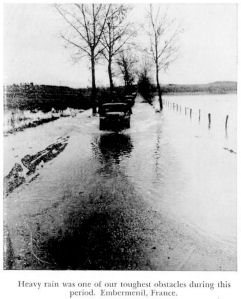
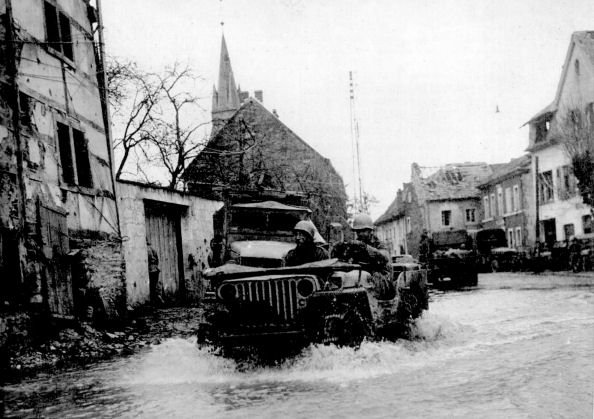
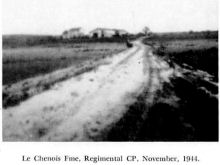
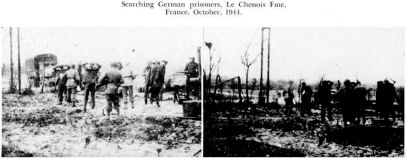 |













